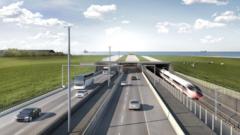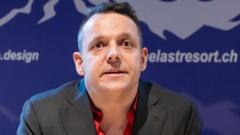The Fehmarnbelt Tunnel, spanning 18km, will revolutionize travel times and environmental impact in the region by linking Denmark's Lolland island and Germany, significantly reducing travel and cutting carbon emissions. Set to be completed by 2029, it will facilitate over 100 trains and 12,000 cars daily, fostering economic growth and job creation.
Denmark-Germany Tunnel Construction Set to Transform Travel in Scandinavia

Denmark-Germany Tunnel Construction Set to Transform Travel in Scandinavia
A groundbreaking engineering project underway aims to construct the longest pre-fabricated road and rail tunnel beneath the Baltic Sea, enhancing connectivity between Denmark and Germany.
A remarkable engineering ambition is in full swing with the construction of the Fehmarnbelt Tunnel, a pioneering underwater route set to redefine travel and connectivity between Denmark and Germany. This unprecedented project, extending 18 kilometers (11 miles), is poised to become the longest pre-fabricated road and rail tunnel globally, aimed at enhancing links between Scandinavia and mainland Europe.
The Fehmarnbelt Tunnel, a crucial endeavor, is designed to significantly shorten travel durations between key cities, namely Hamburg and Copenhagen. With its innovative construction method, the tunnel's segments, referred to as "elements," will be carefully placed atop the seabed and interconnected to form a continuous passage. The main construction site, located on Lolland island in southeastern Denmark, boasts a sprawling 500-hectare area that includes both a factory and a harbor dedicated to producing these massive tunnel components.
"It's a massive facility," emphasizes Henrik Vincentsen, CEO of Femern, the Danish state-owned enterprise spearheading the tunnel's construction. Each tunnel element, measuring 217 meters (712 feet) in length and 42 meters in width, integrates reinforced steel within a concrete shell. Unlike traditional underwater tunnels that tend to burrow through rock, this project will assemble 90 distinct elements akin to a Lego assembly.
This groundbreaking infrastructure project carries a hefty price tag of around €7.4 billion ($8.1 billion; £6.3 billion). Funded primarily by Denmark and partially by a €1.3 billion contribution from the European Commission, the tunnel falls under a broader European initiative designed to enhance intercontinental travel while promoting sustainability by minimizing reliance on air transport.
Once operational, the Fehmarnbelt Tunnel will condense the travel time between Rødbyhavn in Denmark and Puttgarten in Germany to a mere 10 minutes by car or seven minutes by train, effectively replacing the previous 45-minute ferry crossing. Furthermore, the new rail line will cut travel time between Copenhagen and Hamburg in half, making it a greener alternative for both freight and passenger travel.
"This isn't simply connecting Denmark and Germany; it's creating a thoroughfare linking Scandinavia to central Europe," asserts Vincentsen. The project is expected to play a pivotal role in reducing carbon emissions by removing the need for longer journeys, ultimately benefiting the environment.
As cranes tower over the harbor site, construction manager Anders Gert Wede provides insights on the painstaking assembly process. This includes maneuvering the heavy elements, each weighing over 73,000 tonnes, into position underwater using sophisticated GPS and camera technology to ensure precision alignment.
Challenges such as soft seabed conditions prompted engineers to opt for an immersed tunnel rather than a bridge, with concerns regarding shipping traffic also playing a critical role in this decision-making process. Although initially met with opposition from ferry operators and environmental activists worried about marine wildlife, legal challenges have been overcome, allowing the project to proceed.
In a bid to mitigate ecological concerns, a reclamation initiative is in place, which includes planning a 300-hectare wetland nature reserve designed to compensate for construction impacts. Set to open by 2029, the tunnel is anticipated to accommodate over 100 trains and 12,000 vehicles daily, with projected toll revenues aiding in repaying governmental loans incurred for its development.
The substantial investment in the Fehmarnbelt Tunnel is also viewed as a catalyst for economic revitalization in Lolland, often considered one of Denmark's economically challenged areas. As the local community eagerly awaits the completion of this transformative infrastructure, there are hopes not only for job creation but also for a burgeoning tourism industry.
"As someone who grew up nearby, I can say the locals have been eagerly anticipating this project for years," Wede notes with optimism. "Business development is on the horizon, and this tunnel may very well change our future."




















